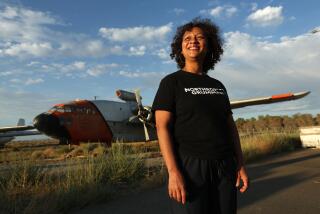Campus Uses Its Air Force to Help Train Ground Force
- Share via
For $1 and some spare parts, Glendale Community College bought itself a helicopter last month.
But don’t expect to see John A. Davitt, the school’s president, landing on campus in a burst of wind and noise.
This helicopter will never fly again. It’s a 47J-2 Bell, circa 1962, which was sold by the City of Los Angeles as surplus equipment.
As soon as the Los Angeles city attorney’s office draws up a contract, the helicopter will be trucked to one of Glendale Community College’s two hangars, where students will learn to take the engine apart, perform maintenance and put it back together.
Two-Year Aviation Program
“That’s the way it’s done in the real world, so that’s the way we teach it,” said Jim Nunnelee, who teaches engine overhauling at the college.
It’s all part of Glendale Community College’s aircraft mechanics program, which has turned out certified mechanics since 1939.
The aviation department’s two-year program, which costs $50 a semester for state residents, trains mechanics who can command as much as $15 an hour for entry-level jobs. They work for commercial airlines, corporations, airport management and manufacturers, said Bill Mallory, who heads the department.
In contrast, private schools such as Northrop University in Inglewood charge about $10,800 for a 16-month program, according to William Bray, a Northrop aviation faculty member.
Glendale’s program is one of about 10 in Southern California certified by the Federal Aviation Administration. Nationwide, about 140 schools, mostly community colleges, offer such programs, according to Jim Rardon, executive secretary of the Aviation Technician Education Council.
85 Students in Program
Glendale’s aircraft maintenance department has about 85 students, four of whom are women.
One student, Doreen Janus, 25, drives in daily from Canyon Country. She has almost completed the mechanics program and wants to work with helicopters.
Janus said she first became intrigued with helicopters several years ago when she was a hospital clerical worker and saw them land outside her window every day to drop off patients.
Although she has no desire to fly, she said she is “fascinated by how they operate and what makes them work.”
What made her pick Glendale’s program?
“I checked out a lot of schools. This one had more hands-on experience, and the teachers seemed to care,” she said.
Classes are taught in two hangars on the southern edge of campus, against the backdrop of the San Rafael Hills. Students learn on equipment that is still used throughout the industry. Planes do not leave the ground.
The sprawling hangars house seven airplanes, three helicopters and many spare parts that have been donated, salvaged or bought at auction for bargain prices.
“We keep our ear to the ground. If we see something sitting around, we’ll ask for it,” Mallory said.
That’s exactly what happened with the surplus helicopter. Clifford Welsh, the city’s director of fleet services, said Mallory found out that the helicopter was to be auctioned and asked the city to donate it to the school instead.
Los Angeles officials declined, saying the helicopter was worth $7,000 to $15,000. But Mallory then sweetened the deal with a fuel control for a Lycoming engine, which the city needed for a helicopter that it recently purchased from the U. S. military.
The Los Angeles City Council approved the swap and $1 payment on Dec. 16, and Mallory expects the helicopter to roll into the department’s hangars by mid-January.
Some items in the school’s hangars are for display only, such as an R4360 Pratt & Whitney engine commissioned by Howard Hughes for his enormous wooden airplane, the Spruce Goose, and a nine-cylinder Packard diesel radial engine, a rare museum piece that Mallory hopes will inspire would-be aviation mechanics.
But most items are used daily, such as the Allison 250 gas-turbine engine donated by Aviall Inc. in Burbank. The engine costs more than $100,000 new--way beyond the department’s reach.
Work on Jet Engines
One of the most formidable engines that students train on is the J-33 jet engine, which comes from a Lockheed P2V, a Korean War-era aircraft used for anti-submarine warfare. It measures five feet high, eight feet long.
“That’s one of the pride and joys of the department,” Nunnelee said.
The engine sits in a soundproof room, in front of a shatterproof, double-paned glass window. Next to it is an exhaust duct that sucks up flames belching from the running engine. Students learn to start the engine and read instrument panels to monitor its speed, temperature, fuel flow and thrust, Mallory said.
Instructors hover nearby to make sure the engine doesn’t burn up from improper handling.
In another maintenance exercise, students come within three feet of whirring helicopter blades to check equipment. Other than several cuts and scrapes incurred by students who have walked absent-mindedly into the wings of a stationary plane, there have been no accidents, Nunnelee said.
Other Aviation Studies
All of the seven aircraft maintenance instructors are licensed pilots, Mallory said, and most have planes of their own. Mallory keeps a Cessna 172 at Van Nuys Airport.
Glendale Community College also has another 250 students in ground-flight training, introductory classes in air-traffic control and a flight-attendant program.
But those programs are only primers for additional classes. Prospective pilots must go elsewhere for flying lessons; the FAA requires air-traffic controllers to graduate from its academy in Oklahoma City, and airlines usually put flight attendants through their own training programs, Mallory said.
Aircraft mechanic students, however, complete their training at Glendale Community College. They spend 50% of their time with textbooks, the other half wearing blue overalls, tinkering with engine parts and getting greasy fingernails.
Students can opt to earn an FAA certificate and go immediately to work or take more courses and earn an associate of arts degree.
Maintenance as a Hobby
Not all students are of typical college age. Frank Morris of Glendale, a retired engineer for the Southern California Gas Co., says he enrolled because the program offered plenty of hands-on experience.
Aircraft maintenance is a hobby for Morris, a pilot who now rents but hopes to buy his own plane some day.
“I love planes. Always have. This program makes you a better pilot,” Morris said. He adds that Van Nuys, Burbank, Los Angeles International and Whiteman airports all hire Glendale College graduates.
“It has a very good reputation,” Morris said.
Stephen Slonneger, owner of Able Air Corp., a repair and maintenance company at Pacoima’s Whiteman Air Park, agrees.
“Glendale’s program is excellent. Of my five mechanics, four are graduates from there,” Slonneger said.
Regardless of their alma mater, well-trained graduates are likely to get snapped up quickly today, educators say. The Aviation Technician Education Council’s Jim Rardon, who also teaches aviation at Purdue University in West Lafayette, Ind., said the industry is facing “one whopping shortage of aviation mechanics.”
Mallory complained that when Continental Airlines wanted to hire five of his best students several months ago, he could round up only one.
The rest had already found jobs or hadn’t yet completed the program.
More to Read
Inside the business of entertainment
The Wide Shot brings you news, analysis and insights on everything from streaming wars to production — and what it all means for the future.
You may occasionally receive promotional content from the Los Angeles Times.










